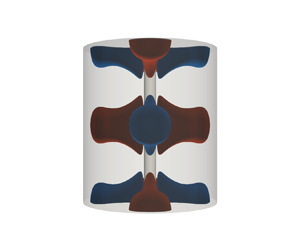No CrossRef data available.
Published online by Cambridge University Press: 19 December 2024

This paper derives the upper bound on heat transport in supergravitational turbulent thermal convection analytically and numerically. Using a piecewise background profile, the functional inequality analysis delivers a suboptimal bound  $Nu\lesssim -({3\sqrt {3}}/{2})({\eta \ln (\eta )}/({1-\eta ^2}))\,Ra^{1/2}$ as
$Nu\lesssim -({3\sqrt {3}}/{2})({\eta \ln (\eta )}/({1-\eta ^2}))\,Ra^{1/2}$ as  $Ra\rightarrow \infty$, where
$Ra\rightarrow \infty$, where  $Nu$ is the Nusselt number,
$Nu$ is the Nusselt number,  $\eta$ is the radius ratio of the inner cylinder to the outer cylinder (
$\eta$ is the radius ratio of the inner cylinder to the outer cylinder ( $0<\eta <1$), and
$0<\eta <1$), and  $Ra$ is the Rayleigh number. A variational problem yielded from Doering–Constantin–Hopf formalism is solved asymptotically and numerically, which delivers a better upper bound than the piecewise background profile. The asymptotic analysis and numerical data indicate that the current best bound is given by
$Ra$ is the Rayleigh number. A variational problem yielded from Doering–Constantin–Hopf formalism is solved asymptotically and numerically, which delivers a better upper bound than the piecewise background profile. The asymptotic analysis and numerical data indicate that the current best bound is given by  $Nu\leqslant -0.106({\eta \ln (\eta )}/({(1-\eta )(1+\sqrt {\eta })^2}))\,Ra^{1/2}$. Both analytical and numerical results demonstrate that the upper bound can be significantly reduced by the curvature effect. Unlike the traditional Rayleigh–Bénard turbulence, in which the optimal perturbation yielded from the variational problem is always two-dimensional, the present study shows that three-dimensional perturbations, annular perturbations and axisymmetric perturbations can be induced by the curvature effect simultaneously. However, we show that the bound yielded from the three-dimensional variational problem is very close to the axisymmetric situation as
$Nu\leqslant -0.106({\eta \ln (\eta )}/({(1-\eta )(1+\sqrt {\eta })^2}))\,Ra^{1/2}$. Both analytical and numerical results demonstrate that the upper bound can be significantly reduced by the curvature effect. Unlike the traditional Rayleigh–Bénard turbulence, in which the optimal perturbation yielded from the variational problem is always two-dimensional, the present study shows that three-dimensional perturbations, annular perturbations and axisymmetric perturbations can be induced by the curvature effect simultaneously. However, we show that the bound yielded from the three-dimensional variational problem is very close to the axisymmetric situation as  $\eta$ increases and
$\eta$ increases and  $Ra$ increases.
$Ra$ increases.